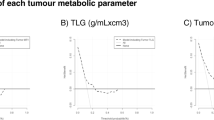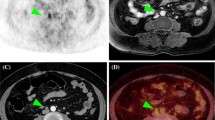Abstract
Objective
To determine whether contrast-enhanced PET/CT is more accurate than either non-enhanced PET/CT or enhanced CT alone for nodal staging of uterine cancer.
Methods
Forty patients with endometrial cancer and cervical cancer underwent conventional PET/CT scan with low-dose CT (ldCT), followed by full-dose CT with IV contrast (ceCT) before radical hysterectomy with pelvic and, when applicable, para-aortic lymphadenectomy. Three data sets of PET/ldCT, PET/ceCT, and enhanced CT images were interpreted separately by two readers. For region-specific comparisons, para-aortic and pelvic lymph nodes were divided into the bilateral para-aortic, common iliac, external iliac, internal iliac, and obturator areas. Based on histopathological findings as the gold standard, we compared the diagnostic accuracy between the three methods using McNemar test with Bonferroni’s adjustment.
Results
Of the 40 patients, 21 underwent pelvic lymphadenectomy only. Region-based analysis showed that the sensitivity, specificity, and accuracy of PET/ceCT were 61.4% (27/44), 98.1% (308/314), and 93.6% (335/358), respectively, whereas those of PET/ldCT were 52.3% (23/44), 96.8% (304/314), and 91.3% (327/358), respectively, and those of enhanced CT were 40.9% (18/44), 97.8% (307/314), and 90.8% (325/358), respectively. Although PET/ceCT had the best sensitivity among the three imaging modalities, a significant difference was observed only between PET/ceCT and enhanced CT (p = 0.0027). Although PET/ceCT had better sensitivity and accuracy than PET/ldCT, the differences between the two imaging methods did not reach statistical significance (p = 0.046 and p = 0.047, respectively).
Conclusion
PET/ceCT is slightly but not significantly superior to PET/ldCT for nodal staging of uterine cancer. Nodal metastasis cannot be excluded even if PET/ceCT gives negative findings.



Similar content being viewed by others
References
International Federation of Gynecology and Obstetrics FIGO staging of gynecologic cancers. Int J Gynecol Cancer. 1995;5(5):319–324.
Manetta A, Delgado G, Petrilli E, Hummel S, Barnes W. The significance of paraaortic node status in carcinoma of the cervix and endometrium. Gynecol Oncol. 1986;23(3):284–90.
Creasman WT, Morrow CP, Bundy BN, Homesley HD, Graham JE, Heller PB. Surgical pathologic spread patterns of endometrial cancer. Cancer. 1987;60(Suppl 8):2035–41.
Inoue T, Morita K. The prognostic significance of number of positive nodes in cervical carcinoma stage IB, IIA, and IIB. Cancer. 1990;65(9):1923–7.
Gal D, Recio FO, Zamurivic D, Tancer ML. Lymphovascular space involvement. A prognostic indicator in endometrial adenocarcinoma. Gynecol Oncol. 1991;42(2):142–5.
Stehman FB, Bundy BN, DiSaia PJ, Keys HM, Larson JE, Fowler WC. Carcinoma of the cervix treated with radiation therapy: a multi-variate analysis of prognostic variables in the Gynecologic Oncology Group. Cancer. 1991;67(11):2776–85.
Lai CH, Hong JH, Hsueh S, Ng KK, Chang TC, Tseng CJ, et al. Preoperative prognostic variables and the impact of postoperative adjuvant therapy on the outcome of stage IB and II cervical carcinoma patients with or without pelvic lymph-node metastases: an analysis of 891 cases. Cancer. 1999;85(7):1537–46.
Comerci G, Bolger BS, Flannelly G, Maini M, de Barros Lopes A, Monaghan JM. Prognostic factors in surgically treated stage IB–IIB carcinoma of the cervix with negative lymph nodes. Int J Gynecol Cancer. 1998;8(1):23–6.
Grigsby PW, Perez CA, Chao KS, Herzog T, Mutch DG, Rader J. Radiation therapy for carcinoma of the cervix with biopsy-proven positive para-aortic lymph nodes. Int J Radiat Oncol Biol Phys. 2001;49(3):733–8.
Shephed JH. Revised FIGO staging for gynaecological cancer. Br J Obstet Gynaecol. 1989;96(8):889–92.
Hricak H, Gatsonis C, Coakley FV, Snyder B, Reinhold C, Schwartz LH, et al. Early invasive cervical cancer: CT and MR imaging in preoperative evaluation—ACRIN/GOG comparative study of diagnostic performance and interobserver variability. Radiology. 2007;245(2):491–8.
Choi HJ, Roh JW, Seo SS, Lee S, Kim JY, Kim SK, et al. Comparison of the accuracy of magnetic resonance imaging and positron/emission tomography in the presurgical detection of lymph node metastases in patients with uterine cervical carcinoma. Cancer. 2006;106(4):914–22.
Rockall AG, Sohaib SA, Harisinghani MG, Babar SA, Singh N, Jeyarajah AR, et al. Diagnostic performance of nanoparticle-enhanced magnetic resonance imaging in the diagnosis of lymph node metastases in patients with endometrial and cervical cancer. J Clin Oncol. 2005;23(12):2813–21.
Rockall AG, Meroni R, Sohaib SA, Reynolds K, Alexander-Sefre F, Shepherd JH, et al. Evaluation of endometrial carcinoma on magnetic resonance imaging. Int J Gynecol Cancer. 2007;17(1):188–96.
Sironi S, Buda A, Picchio M, Perego P, Moreni R, Pellegrino A, et al. Lymph node metastasis in patients with clinical early-stage cervical cancer: detection with integrated FDG PET/CT. Radiology. 2006;238(1):272–9.
Amit A, Beck D, Lowenstein L, Lavie O, Bar Shalom R, Kedar Z, et al. The role of hybrid PET/CT in the evaluation of patients with cervical cancer. Gynecol Oncol. 2006;100(1):65–9.
Loft A, Berthelsen AK, Roed H, Ottosen C, Lundvall L, Knudsen J, et al. The diagnostic value of PET/CT scanning in patients with cervical cancer: a prospective study. Gynecol Oncol. 2007;106(1):29–34.
Yildirim Y, Sehirali S, Avci ME, Yilmaz C, Ertopcu K, Tinar S, et al. Integrated PET/CT for the evaluation of para-aortic nodal metastasis in locally advanced cervical cancer patients with negative conventional CT findings. Gynecol Oncol. 2008;108(1):154–9.
Chung HH, Park NH, Kim JW, Song YS, Chung JK, Kang SB. Role of integrated PET–CT in pelvic lymph node staging of cervical cancer before radical hysterectomy. Gynecol Obstet Invest. 2009;67(1):61–6.
Kitajima K, Murakami K, Yamasaki E, Kaji Y, Sugimura K. Accuracy of integrated FDG-PET/contrast-enhanced CT in detecting pelvic and paraaortic lymph node metastasis in patients with uterine cancer. Eur Radiol. 2009;19(6):1529–36.
Kitajima K, Murakami K, Yamasaki E, Fukasawa I, Inaba N, Kaji Y, et al. Accuracy of FDG PET/CT in detecting pelvic and paraaortic lymph node metastasis in patients with endometrial cancer. AJR Am J Roentgenol. 2008;190(6):1652–8.
Park JY, Kim EN, Kim DY, Suh DS, Kim JH, Kim YM, et al. Comparison of the validity of magnetic resonance imaging and positron emission tomography/computed tomography in the preoperative evaluation of patient with uterine corpus cancer. Gynecol Oncol. 2008;108(3):486–92.
Nayot D, Kwon JS, Carey MS, Driedger A. Does preoperative positron emission tomography with computed tomography predict nodal status in endometrial cancer? A pilot study. Curr Oncol. 2008;15(3):123–5.
Signorelli M, Guerra L, Buda A, Picchio M, Mangili G, Dell’Anna T, et al. Role of the integrated FDG PET/CT in the surgical management of patients with high risk clinically early stage endometrial cancer; detection of pelvic nodal metastases. Gynecol Oncol. 2009;115(2):231–5.
Chan JK, Cheung MK, Huh WK, Osann K, Husain A, Teng NN, et al. Therapeutic role of lymph node resection in endometrioid corpus cancer: a study of 12,333 patients. Cancer. 2006;107(8):1823–30.
Sugawara Y, Eisbruch A, Kosuda S, Recker BE, Kison PV, Wahl RL. Evaluation of FDG PET in patients with cervical cancer. J Nucl Med. 1999;40(7):1125–31.
Coleman RE, Delbeke D, Guiberteau MJ, Conti PS, Royal HD, Weinre JC, et al. Concurrent PET/CT with an integrated imaging system: intersociety dialogue from the joint working group of the American College of Radiology, the Society of Nuclear Medicine, and the Society of Computed Body Tomography and Magnetic Resonance. J Nucl Med. 2005;46(7):1225–39.
Antoch G, Freudenberg LS, Beyer T, Bockisch A, Debatin JF. To enhance or not to enhance? 18F-FDG and CT contrast agents in dual-modality 18F-FDG PET/CT. J Nucl Med. 2004;45(1):56–65.
Rodriguez-Vigil B, Gomez-Leon N, Pinilla I, Hernandez-Maraver D, Coya J, Martin-Curto L, et al. PET/CT in lymphoma: prospective study of enhanced full-dose PET/CT versus unenhanced low-dose PET/CT. J Nucl Med. 2006;47(10):1643–8.
Pfannenberg AC, Aschoff P, Brechtel K, Muller M, Bares R, Paulsen F, et al. Low dose non-enhanced CT versus standard dose contrast-enhanced CT in combined PET/CT protocols for staging and therapy planning in non-small cell lung cancer. Eur J Nucl Med Mol Imaging. 2007;34(1):36–44.
Tateishi U, Maeda T, Morimoto T, Miyake M, Arai Y, Kim EE. Non-enhanced CT versus contrast-enhanced CT in integrated PET/CT studies for nodal staging of rectal cancer. Eur J Nucl Med Mol Imaging. 2007;34(10):1627–34.
Morimoto T, Tateishi U, Maeda T, Arai Y, Nakajima Y, Kim EE. Nodal status of malignant lymphoma in pelvic and retroperitoneal lymphatic pathways: comparison of integrated PET/CT with or without contrast enhancement. Eur J Radiol. 2008;67(3):508–13.
Strobel K, Heinrich S, Bhure U, Soyka J, Veit-Haibach P, Pestalozzi BC, et al. Contrast-enhanced 18F-FDG PET/CT: 1-stop-shop imaging for assessing the resectability of pancreatic cancer. J Nucl Med. 2008;49(9):1408–13.
Kitajima K, Murakami K, Yamasaki E, Domeki Y, Kaji Y, Fukasawa I, et al. Performance of integrated FDG-PET/contrast-enhanced CT in the diagnosis of recurrent ovarian cancer: comparison with integrated FDG-PET/non-contrast-enhanced CT and enhanced CT. Eur J Nucl Med Mol Imaging. 2008;35(8):1439–48.
Soyka JD, Veit-Haibach P, Strobel K, Breitenstein S, Tschopp A, Mende KA, et al. Staging pathways in recurrent colorectal carcinoma: is contrast-enhanced 18F-FDG PET/CT the diagnostic tool of choice? J Nucl Med. 2008;49(3):354–61.
Kitajima K, Murakami K, Yamasaki E, Domeki Y, Kaji Y, Suganuma M, et al. Performance of integrated FDG-PET/contrast-enhanced CT in the diagnosis of recurrent colorectal cancer: comparison with integrated FDG-PET/non-contrast-enhanced CT and enhanced CT. Eur J Nucl Med Mol Imaging. 2009;36(9):1388–96.
Kitajima K, Suzuki K, Nakamoto Y, Onishi Y, Sakamoto S, Senda M, et al. Low-dose non-enhanced CT versus full-dose contrast-enhanced CT in integrated PET/CT studies for the diagnosis of uterine cancer recurrence. Eur J Nucl Med Mol Imaging. 2010;37(8):1490–8.
Mawlawi O, Erasmus JJ, Munden RF, Pan T, Knight A, Macapinlac HA, et al. Quantifying the effect of IV contrast media on integrated PET/CT: clinical evaluation. AJR Am J Roentgenol. 2006;186(2):308–19.
Acknowledgments
We thank Hiroyoshi Okajima, Keita Miyamoto, Eiji Takeda, and Kazuhiro Kubo for their excellent technical assistance and generous support.
Conflict of interest
We received no financial support.
Author information
Authors and Affiliations
Corresponding author
Rights and permissions
About this article
Cite this article
Kitajima, K., Suzuki, K., Senda, M. et al. Preoperative nodal staging of uterine cancer: is contrast-enhanced PET/CT more accurate than non-enhanced PET/CT or enhanced CT alone?. Ann Nucl Med 25, 511–519 (2011). https://doi.org/10.1007/s12149-011-0496-9
Received:
Accepted:
Published:
Issue Date:
DOI: https://doi.org/10.1007/s12149-011-0496-9




